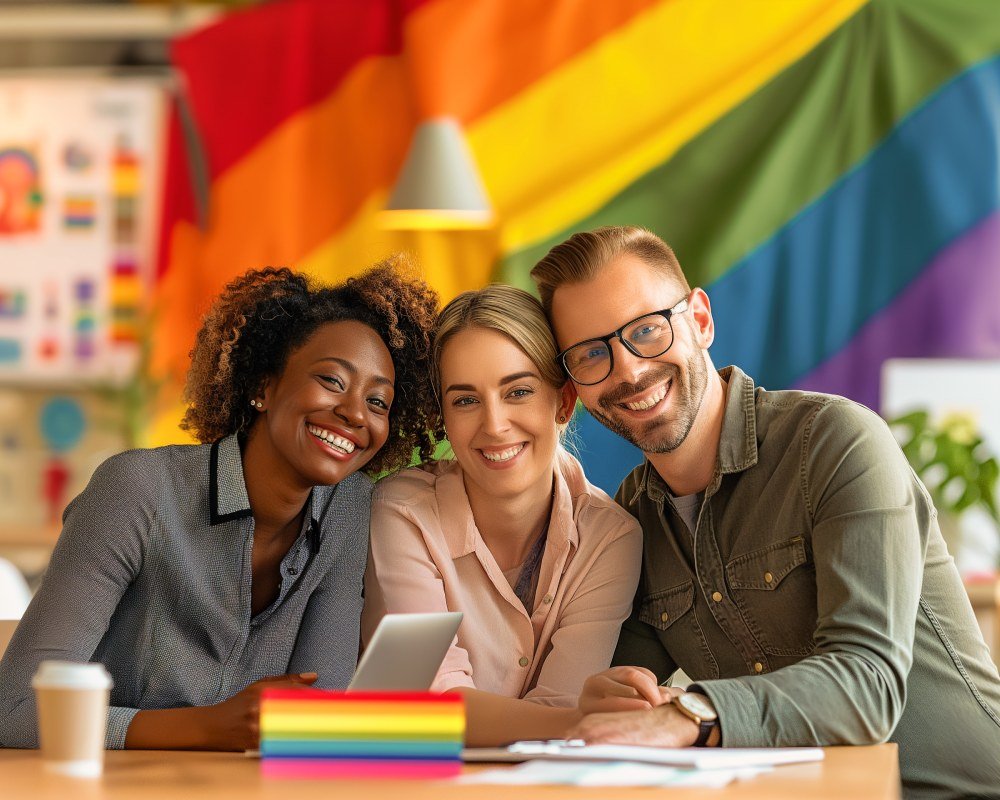
The Evolution of LGBTQ+ Marketing Over the Decades – Marketing to the LGBTQ+ community has undergone significant changes over the decades. From early representations to today’s inclusive and diverse campaigns, the journey of LGBTQ+ marketing reflects broader societal shifts and the growing recognition of the LGBTQ+ community’s importance. Gay Thrive LGBTQ+ Marketing Agency, dedicated to serving this vibrant community, offers insights into the evolution of LGBTQ+ marketing over the decades. This blog explores the history, challenges, and triumphs in LGBTQ+ marketing, providing valuable lessons and predictions for the future.
The Beginnings: Early LGBTQ+ Representation in Marketing
The evolution of LGBTQ+ marketing over the decades began with small, often subtle representations. In the early days, LGBTQ+ individuals rarely saw themselves reflected in mainstream advertising. When they were included, it was often through coded messages or ambiguous imagery that could be interpreted in multiple ways.
One of the earliest known advertisements targeting gay men was a 1917 ad for Arrow Collars, which featured two men in a close, intimate pose. However, such representations were rare, and overt LGBTQ+ marketing was practically nonexistent. Brands feared backlash and societal disapproval, leading to a lack of visibility for the LGBTQ+ community.

The 1970s: The Rise of Visibility and Advocacy
The 1970s marked a turning point in the evolution of LGBTQ+ marketing over the decades. The gay rights movement gained momentum following the Stonewall Riots of 1969, leading to increased visibility and advocacy. This period saw the emergence of niche publications and businesses catering specifically to the LGBTQ+ community.
Gay magazines like “The Advocate” and “Out” became important platforms for LGBTQ+ advertising. Brands started to recognize the economic power of the LGBTQ+ community, leading to more targeted marketing efforts. However, mainstream brands were still hesitant to openly embrace LGBTQ+ themes, and most advertising remained confined to LGBTQ+ media outlets.
Advertisement · Scroll to continue
Recommended
The 1980s: Responding to the AIDS Crisis in Marketing
The 1980s brought significant challenges and changes in the evolution of LGBTQ+ marketing over the decades. The AIDS crisis had a profound impact on the LGBTQ+ community, leading to widespread stigma and discrimination. However, it also sparked a wave of activism and solidarity.
During this period, some brands began to address the crisis through their marketing efforts. For example, Benetton’s controversial “AIDS” campaign in 1992 featured a powerful image of a man dying of AIDS, bringing much-needed attention to the epidemic. While such campaigns were groundbreaking, they were also met with significant controversy and resistance.

The 1990s: Increasing Representation in Mainstream Media
The 1990s saw a significant shift in the evolution of LGBTQ+ marketing over the decades, with increasing representation in mainstream media. Television shows like “Will & Grace” and “Ellen” brought LGBTQ+ characters into millions of homes, challenging stereotypes and fostering acceptance.
This increased visibility extended to advertising as well. IKEA’s 1994 commercial featuring a gay couple shopping for a dining table was one of the first mainstream ads to depict a same-sex couple. The ad was groundbreaking, but it also faced backlash and led to boycotts. Despite this, it paved the way for more inclusive advertising in the years to come.
The 2000s: The Impact of Digital Media on LGBTQ+ Marketing
The advent of digital media in the 2000s revolutionized the evolution of LGBTQ+ marketing over the decades. The rise of the internet and social media provided new platforms for reaching LGBTQ+ audiences, offering unprecedented opportunities for engagement and visibility.
Brands like Absolut Vodka and American Airlines began to actively court the LGBTQ+ community through targeted digital campaigns. Social media allowed for direct interaction with LGBTQ+ customers, fostering a sense of community and loyalty. The digital age also saw the rise of LGBTQ+ influencers, who played a crucial role in shaping and promoting inclusive marketing efforts.

Advertisement · Scroll to continue
Recommended
The 2010s: The Shift Towards Inclusivity and Diversity
The 2010s marked a significant shift towards inclusivity and diversity in the evolution of LGBTQ+ marketing over the decades. As societal attitudes towards LGBTQ+ individuals became more accepting, brands began to embrace inclusivity as a core value.
Campaigns like Tiffany & Co.’s 2015 ad featuring a same-sex couple and the 2016 “Love Has No Labels” campaign by the Ad Council showcased diverse representations of love and relationships. These campaigns were celebrated for their authenticity and inclusivity, reflecting a broader cultural shift towards acceptance and equality.
The Role of Social Media in Modern LGBTQ+ Marketing
Social media continues to play a crucial role in the evolution of LGBTQ+ marketing over the decades. Platforms like Instagram, Twitter, and TikTok provide powerful tools for reaching LGBTQ+ audiences and amplifying diverse voices.
Brands can engage with LGBTQ+ customers directly, creating authentic connections and fostering community. Social media campaigns that celebrate Pride Month, highlight LGBTQ+ stories, and promote inclusive values have become increasingly common. The interactive nature of social media allows brands to receive immediate feedback and adapt their strategies in real time.

Highlighting Key Campaigns that Shaped LGBTQ+ Marketing
Throughout the evolution of LGBTQ+ marketing over the decades, several key campaigns have left a lasting impact. These campaigns not only advanced LGBTQ+ representation but also set new standards for inclusivity in advertising.
One notable example is the “Proud Whopper” campaign by Burger King in 2014. The campaign featured a special edition Whopper wrapped in rainbow-colored packaging, with the message “We Are All the Same Inside.” The campaign was a hit, resonating with both LGBTQ+ customers and allies.
Another significant campaign is the 2017 “Fearless Girl” statue by State Street Global Advisors. While not exclusively an LGBTQ+ campaign, the statue became a symbol of empowerment and inclusivity, inspiring many similar initiatives.
Challenges and Triumphs: Lessons Learned Over the Decades
The evolution of LGBTQ+ marketing over the decades has not been without its challenges. Brands have faced backlash, boycotts, and criticism for their LGBTQ+ inclusive efforts. However, these challenges have also led to important lessons and triumphs.
One key lesson is the importance of authenticity. Performative or insincere efforts can backfire, damaging a brand’s reputation. Successful LGBTQ+ marketing requires genuine commitment to inclusivity and diversity, as well as active involvement from LGBTQ+ individuals in the planning and execution of campaigns.
Another lesson is the need for continuous education and adaptation. Societal attitudes towards LGBTQ+ individuals are constantly evolving, and brands must stay informed and responsive to these changes. Regularly seeking feedback from LGBTQ+ customers and engaging with LGBTQ+ organizations can help ensure that marketing efforts remain relevant and respectful.

The Future of LGBTQ+ Marketing: Trends and Predictions
Looking ahead, the future of LGBTQ+ marketing promises continued evolution and innovation. As brands become more attuned to the needs and preferences of LGBTQ+ customers, several trends and predictions can be anticipated.
One trend is the increasing emphasis on intersectionality. LGBTQ+ marketing will likely focus more on the diverse experiences within the community, including those of LGBTQ+ individuals who also belong to other marginalized groups. This approach will require nuanced and inclusive strategies that address multiple layers of identity.
Another prediction is the growing importance of purpose-driven marketing. Brands that align their marketing efforts with broader social and environmental causes, including LGBTQ+ rights, will likely resonate more with customers. Authentic advocacy and support for LGBTQ+ issues will become key differentiators for brands.
The evolution of LGBTQ+ marketing over the decades will also continue to be shaped by technological advancements. Virtual reality, augmented reality, and other emerging technologies will provide new opportunities for immersive and interactive LGBTQ+ marketing experiences.
Conclusion – The Evolution of LGBTQ+ Marketing Over the Decades
The evolution of LGBTQ+ marketing over the decades has been a journey of progress, challenges, and triumphs. From early, subtle representations to today’s inclusive and diverse campaigns, the history of LGBTQ+ marketing reflects broader societal changes and the growing recognition of the LGBTQ+ community’s importance.
Gay Thrive LGBTQ+ Marketing Agency is committed to helping businesses navigate this evolving landscape, offering specialized marketing services that enhance brand identity, visibility, and customer loyalty. For more insights and personalized support in LGBTQ+ marketing, visit Gay Thrive and discover how our expertise can help your brand thrive in today’s diverse marketplace.
As we look to the future, the evolution of LGBTQ+ marketing over the decades will continue to be driven by authenticity, inclusivity, and innovation. By staying informed, responsive, and committed to genuine support for the LGBTQ+ community, brands can create meaningful connections and lasting impact.
Advertisement · Scroll to continue

More Recommended
Why is everyone boycotting Walmart?
Why is everyone boycotting Walmart? – In recent times, the question on many minds has [...]
From Margins to Mainstream: The Growing Influence of Lesbian Businesses in Marketing
From Margins to Mainstream: The Growing Influence of Lesbian Businesses in Marketing Lesbian businesses have [...]
Top 12 Tips When Booking Your Olivia Cruise
Top 12 Tips When Booking Your Olivia Cruise – Going on a cruise is always [...]
Tips for Creating LGBTQ+ Inclusive Products and Services
Tips for Creating LGBTQ+ Inclusive Products and Services – Creating products and services that cater [...]
What Is Gay Pride Parade?
What Is Gay Pride Parade? Exploring Its History, Significance, and Global Impact If you’ve ever [...]
How Gay-Owned Brands are Redefining Beauty Standards in Advertising
How Gay-Owned Brands are Redefining Beauty Standards in Advertising It’s no secret that the beauty [...]
How to make a workplace more gender inclusive?
How to make a workplace more gender inclusive? – Creating a gender-inclusive workplace is not [...]
99+ Funny Lesbian Jokes: Lesbian Jokes
99+ Funny Lesbian Jokes: Lesbian Jokes for Queer Joy & Giggles – Humor has always [...]
The Key Principles of a Lesbian-Owned Marketing Agency
Inclusivity and Authenticity: The Key Principles of a Lesbian-Owned Marketing Agency As businesses strive to [...]